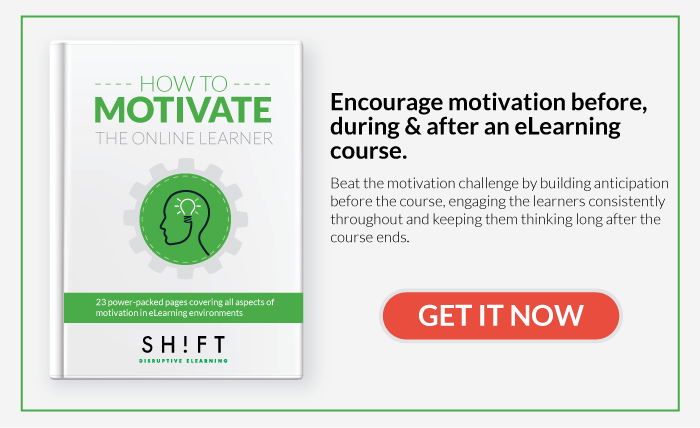In today's eLearning environment, success metrics have evolved beyond simply ticking off course completions. Today, the true measure lies in the depth of a learner's engagement with the content. This shift in focus recognizes that being logged in isn’t the same as being tuned in.
The importance of engagement in online training stems from several key benefits:
-
First, active engagement indicates that learners are not merely going through the motions, but are truly engaged with the material. This active involvement is crucial for combatting the potential sense of isolation that can come with online formats, and it's a fundamental aspect of making eLearning effective.
-
Second, there is a proven correlation between engagement and retention of knowledge. The more engaged learners are, the better they internalize and apply the knowledge, enhancing both their personal performance and that of the organization.
-
Third, boosting engagement helps cultivate a culture of continuous learning. In a rapidly changing job market, the ability to adapt and learn new skills quickly is indispensable. Online courses that keep participants engaged also encourage them to take charge of their own learning and growth.
The key question now is, how can we effectively foster this engagement and motivate learners to fully commit to their eLearning courses?
What is engagement in the context of eLearning?
What exactly do we mean by "engagement" in the context of eLearning?
When discussing engagement in online training, we’re referring to a range of factors that gauge how effectively employees interact with and commit to the content.
Engagement goes beyond course completion. It encompasses several crucial dimensions:
-
Login Frequency: Track how often each learner logs into the eLearning platform. Frequent logins can indicate high interest and engagement with the course material.
-
Time Spent: This measures the amount of time employees actively dedicate to a course. It involves more than just watching videos or reading materials; it includes the time spent on interactive activities and content review.
-
Page Views: Monitor the number of pages or screens viewed by learners during a session. This can help identify whether learners are exploring the content thoroughly.
-
Interaction Rate: Look at how learners interact with interactive elements such as simulations, branching scenarios, and embedded questions. High interaction rates often reflect a high level of engagement.
-
Average Session Length: Measure the average amount of time learners spend in the eLearning system per session. Longer sessions can suggest deeper engagement.
-
Progress Over Time: Assess how quickly learners are progressing through the course. Rapid progress can indicate good engagement, particularly if coupled with high performance on assessments.
-
Performance on Assessments: Assessments are a vital tool for gauging engagement. High performance on tests and exercises indicates that employees are not just spending time on the course, but are truly grasping and internalizing the content.
-
Participation in Forums and Discussions: The degree to which employees participate in forums and discussions is a critical indicator of their involvement. This active participation demonstrates that they are not merely consuming the content passively but are also processing and exchanging ideas and perspectives with others.
-
Feedback and Comments: The feedback employees leave about a course offers deep insights into their level of satisfaction and engagement. Both positive and constructive feedback, along with suggestions for improvement, serve as strong indicators of their engagement levels.
-
Course Completion Speed: The time it takes a learner to complete the course relative to the norm (either too fast or too slow) can provide insights into their level of engagement and understanding of the material.
-
Certification and Badges Earned: Track the number of certifications or digital badges learners earn upon completing courses or achieving specific milestones. These are tangible indicators of accomplishment and engagement.
These metrics, when analyzed together, can provide a comprehensive view of learner engagement and help identify strengths and areas for improvement in your eLearning programs.
Now, we'll outline some key strategies that can be applied to boost engagement:
1- Set Clear eLearning Engagement Metrics
Boosting engagement in eLearning programs begins with understanding exactly what to measure and how. It's similar to analyzing a soccer game; you don't just focus on the score. You also track ball possession, shots on goal, and fouls to get a full picture of the game's dynamics.
Here’s a straightforward plan to get you going:
-
Figure Out What Matters: First, decide what parts of engagement are important for your team. Is it about how often people log in, finish courses, talk to each other, or use what they learn? Set clear goals that focus on these aspects.
-
Talk to Your Team: Chat with the people who make the courses, lead teams, and take the courses themselves. Ask them what they think makes for a good, engaging online course. You'll want to know if the content is easy to access and useful for their work.
-
Use the Right Tools: Use eLearning platforms that can track these things for you and give you easy-to-understand reports.
-
Make It Fit Your Needs: Adjust these metrics so they make sense for your company’s culture and goals. Make sure they can change as your company grows and changes.
-
Keep Checking In: Regularly check how these metrics are doing. Be ready to tweak things if you find new ways to improve or if your team’s needs change.
By taking these steps, you’re not just measuring stuff—you’re actively making your eLearning programs better and more engaging.
Also read: Why and How to Measure Engagement in Your eLearning Programs
2- Deliver Content When It's Needed Most
In today’s fast-paced world, where everything is just a click away, waiting for information can feel as outdated as sending a fax. That's why, in the realm of eLearning, providing content precisely when learners need it isn't just convenient—it's a critical strategy for maintaining their interest and engagement.
Imagine an employee who's out of the office and suddenly needs to look up a specific procedure. Instead of sifting through a mountain of files or waiting to get back to their desk, they receive a notification on their phone with a micro-video or an infographic outlining the steps they need to take. It's practical, quick, and effective, boosting their confidence in using eLearning resources and encouraging ongoing use.
How can we deliver content just in time? Here are a few ideas:
-
Modular and Accessible Content: Develop bite-sized learning capsules, like five-minute video tutorials or quick infographics, that employees can easily search for and consume when they face a specific challenge at work.
-
Proactive Support in Tough Times: If someone is struggling, the system could provide additional resources to support their learning at that critical moment. For example, if an employee fails a quiz, they could immediately receive interactive exercises on their mobile device to practice, along with encouraging messages like, "Don't worry, we all face challenges. Here are some extra examples to practice before your next attempt."
-
Real-Time Feedback: Implement tools that provide immediate feedback on employees' actions. This feedback could be as simple as a pop-up message congratulating the user for completing a section or offering tips for improvement after an evaluation.
-
Re-engaging Inactive Users: If the system notices that an employee hasn’t interacted with the course recently, sending engaging and concise content to their mobile could be just the nudge they need. A message might read, "Did you know the latest module we added can help with the project you’re working on? Check it out when you have a moment." This reminds them that learning is still available and relevant to their current needs.
-
Optimized Mobile Content: Ensure that content is not only accessible on mobile devices but also optimized for a smooth and enjoyable user experience. This means content should be brief, visually appealing, and easy to navigate, perfectly suited for small screens and short attention spans.
Also read: Is Your Company Embracing Just-in-Time Learning?
3- Applying Best Practices in Instructional Design
Instructional design plays a crucial role in determining the level of engagement in eLearning programs. If a course isn't designed with the target audience in mind, there's a high risk that participants will either become bored or not retain the information effectively. This can lead to a lack of motivation and, consequently, lower participation in the course.
Therefore, it's essential to apply best practices in instructional design that not only meet the evolving needs of learners but also keep them continuously engaged and motivated to actively participate in the learning process.
Here are some ways to achieve this:
-
Dynamic Course Introduction: Skip the long, tedious introductions. Opt for a concise, engaging welcome that grabs attention right away. A two-minute welcome video can be enough to excite participants, showing them how exciting and useful the course will be for their professional development.
-
Development of Content Microcapsules: Design short modules focused on specific skills that can be completed in a single session. For instance, a micro-module titled "Effective Presentation Techniques" could provide practical tips right before a major presentation, facilitating just-in-time and highly applicable learning.
-
Digital Badges as Recognition: Similar to rewards in video games, implement digital badges that learners earn upon completing certain modules or challenges. These badges, which can be displayed on professional profiles, not only recognize achievements but also motivate others to reach similar goals.
-
User-Centered Design: Maintain a user-focused approach when designing content, constantly asking yourself: Will this facilitate and enrich the learners' experience? Ensuring the answer is yes not only guarantees the relevance of the content but also significantly boosts learner engagement.
-
Personalized Learning Paths: Create learning paths tailored to the specific needs of different roles within the organization. For example, a project manager might follow a path focused on team management, while a programmer might pursue one centered on advanced coding skills. Enhance these paths with the option for mobile learning, allowing learners to access courses from anywhere and at any time, thus increasing flexibility and accessibility.
Recommended read:
- 10 Ideas to Create Engaging eLearning Courses
- Use These 5 Instructional Design Strategies to Create an Effective eLearning Course
Let’s wrap up by emphasizing the essentials: If we want to make eLearning effective, we need to focus on three main strategies—accurate measurement of engagement, delivering content when it’s most relevant, and crafting courses that are both interesting and practical. These approaches go beyond simply improving the learning experience; they help us use our time and resources wisely on training that truly matters.
Now is the perfect time for every organization to reflect:
-
Are you really engaging your employees with your current eLearning initiatives?
-
Is your training actually adding value, or just filling time?
It’s critical to challenge our current methods and continually ask if we can do better. Each course should be more than just content; it should be a vital tool that fosters an energetic and engaged learning atmosphere.
Remember, effective eLearning isn’t about ticking off boxes. It’s about igniting a passion for learning that translates into tangible skills and knowledge.
Ultimately, the success of any eLearning program should be measured by its impact on the daily work lives of employees and the overall effectiveness of the organization. By keeping your training relevant, engaging, and directly connected to your employees' roles, you’ll foster a robust learning culture that not only educates but also inspires.



